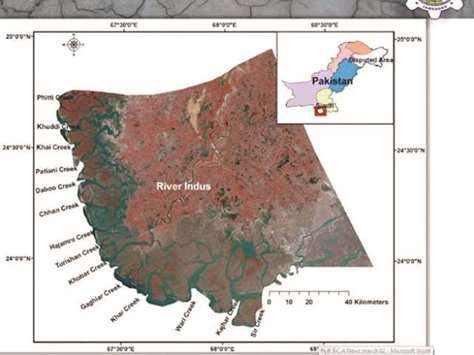In 1833, the delta of the Indus River was estimated to be stretching out over an area of around 12,900sq km.
However, the human impact on the environment and natural flow of the river has resulted in the contraction of the delta by as much as 92% in the past 200 years.
This was established in the results of a 15-month study conducted by a team of five academics of the United States-Pakistan Centre for Advanced Studies in Water (USPCASW) at Mehran University of Engineering and Technology (MUET), Jamshoro.
For decades, affected communities, environmental activists and academics have been highlighting the issue of sea intrusion and its consequences for the coast, delta and locals.
However, the need for an authentic estimation of the sea intrusion was being felt by researchers.
The USPCASW team’s study was an attempt to fulfil that need with the help of satellite imagery and other research tools.
The research findings, which also included the coastal communities’ perception about the sea intrusion’s impact as well as recommendations to address the problem, were shared at a seminar at USPCASW yesterday.
“The delta has shrunk by 92% [from 12,900sq km]. It currently stretches over a meagre 1,000sq km,” lead researcher Prof Dr Altaf Ali Siyal said.
There are only two active creeks, Khobar and Khar creeks, in the delta which once had as many as 17 active creeks, he added.
The Indus delta is the fifth largest in the world, besides being a designated wetland according to the Ramsar Convention, the international treaty which provides the framework for the conservation and wise use of wetlands and their resources.
The delta supports the seventh biggest mangrove forest and is the largest arid zone mangrove forest.
Currently, it is being threatened by erosion, sea intrusion, soil salinity, declining river flow, shrinking active delta and climate change.
The researchers studied satellite images of the Indus delta’s creeks of the last 45 years starting from 1972.
The creeks were divided in four zones, with two each on the right and left banks of the river.
On the left side, the area from Sir Creek to Wari Creek was designated as zone I while the area between Wari and Khobar creeks was termed zone II.
On the right side, the area between Khobar and Daboo creeks was designated as zone III while the area between Daboo and Phitti creeks was termed zone IV.
The study measured the shoreline erosion rate to be 45.69m per year in zone I and 52.1m per year in zone II.
In zone III and zone IV, erosion of 27.21m per year and 31.43m per year was calculated respectively.
The highest intrusion was observed in zone II where the sea has encroached upon 1.24km, followed by zone I where 1.1km was conquered by the sea.
The Indus delta lies in Thatta and Sujawal districts.
According to the study, the latter district, which is located on the left bank, has suffered more from the erosion.
During the last four-and-a-half decades, the sea also added 42,609 hectares of delta in its tidal flood plain (TFP), which is submerged during high tide.
In 1972, the pace of TFP was measured at 7.1%, whereas by 2017, it almost tripled to over 18%.
Some 81,324 hectares of the TFP are covered by mangroves, including thick mangroves, which occupy 36,245 hectares and thin mangroves, which occupy 45,079 hectares.
However, the total percentage of the TFP covered by mangroves is just 12%.
Water bodies containing seawater in the delta have doubled from 1,600sq km to 3,000sq km, Siyal said.
“We find a lake after every two to three kilometres in the delta,” he added.
The research also studied effects of sea intrusion on the local population.
According to the research, 76% locals use underground water to drink, which has become brackish and saline in over 88% area of the delta.
Turbidity, electrical conductivity, acidity level and percentages of chloride and arsenic in the underground water have been found far beyond the World Health Organisation’s permissible limits.
In addition to sea intrusion, the study also looked into changes in temperature and perspiration.
It found that from 1960 to 1990, an average of 100mm of rain was recorded during the monsoon in July.
However, during the period from 1990 to 2015, a drop of 40% in rainfall was recorded.
Similarly, average temperature from March to July also showed an increase in the period from 1990 to 2015.
According to the study, the delta produced 5,000 tonnes of fish in 1951.
But the catch has now drastically slumped to only 295 tonnes.
The researchers have proposed construction of a sea levee covering at least 200km of the coastline.
Former prime minister Nawaz Sharif, during his visit to Thatta district in 2016, had announced a similar project but it has yet to materialise.
The other recommendations include increasing the flow of water in the Pinyari and KB Feeder canals, restoring 15 defunct creeks, plantation of mangroves, cultivation of halophytes, increasing farming of shrimps and crabs, releasing 10mn acre-feet of water downstream Kotri barrage and promoting tourism.

A map of the delta of the Indus River, courtesy of Prof Siyal.


